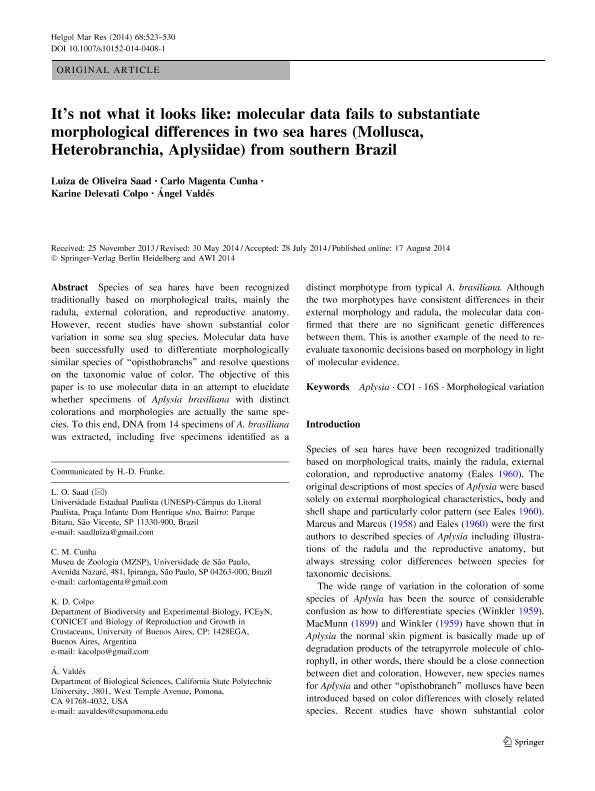Mostrar el registro sencillo del ítem
dc.contributor.author
Saad, Luiza de Oliveira
dc.contributor.author
Cunha, Carlo Magenta
dc.contributor.author
Delevati Colpo, Karine

dc.contributor.author
Valdés, Ángel
dc.date.available
2019-09-25T21:49:32Z
dc.date.issued
2014-11
dc.identifier.citation
Saad, Luiza de Oliveira; Cunha, Carlo Magenta; Delevati Colpo, Karine; Valdés, Ángel; It’s not what it looks like: molecular data fails to substantiate morphological differences in two sea hares (Mollusca, Heterobranchia, Aplysiidae) from southern Brazil; Springer; Helgoland Marine Research; 68; 4; 11-2014; 523-530
dc.identifier.issn
1438-387X
dc.identifier.uri
http://hdl.handle.net/11336/84491
dc.description.abstract
Species of sea hares have been recognized traditionally based on morphological traits, mainly the radula, external coloration, and reproductive anatomy. However, recent studies have shown substantial color variation in some sea slug species. Molecular data have been successfully used to differentiate morphologically similar species of “opisthobranchs” and resolve questions on the taxonomic value of color. The objective of this paper is to use molecular data in an attempt to elucidate whether specimens of Aplysia brasiliana with distinct colorations and morphologies are actually the same species. To this end, DNA from 14 specimens of A. brasiliana was extracted, including five specimens identified as a distinct morphotype from typical A. brasiliana. Although the two morphotypes have consistent differences in their external morphology and radula, the molecular data confirmed that there are no significant genetic differences between them. This is another example of the need to re-evaluate taxonomic decisions based on morphology in light of molecular evidence.
dc.format
application/pdf
dc.language.iso
eng
dc.publisher
Springer

dc.rights
info:eu-repo/semantics/openAccess
dc.rights.uri
https://creativecommons.org/licenses/by/2.5/ar/
dc.subject
16S
dc.subject
APLYSIA
dc.subject
CO1
dc.subject
MORPHOLOGICAL VARIATION
dc.subject.classification
Zoología, Ornitología, Entomología, Etología

dc.subject.classification
Ciencias Biológicas

dc.subject.classification
CIENCIAS NATURALES Y EXACTAS

dc.title
It’s not what it looks like: molecular data fails to substantiate morphological differences in two sea hares (Mollusca, Heterobranchia, Aplysiidae) from southern Brazil
dc.type
info:eu-repo/semantics/article
dc.type
info:ar-repo/semantics/artículo
dc.type
info:eu-repo/semantics/publishedVersion
dc.date.updated
2019-09-24T12:52:37Z
dc.identifier.eissn
1438-3888
dc.journal.volume
68
dc.journal.number
4
dc.journal.pagination
523-530
dc.journal.pais
Alemania

dc.journal.ciudad
Berlin
dc.description.fil
Fil: Saad, Luiza de Oliveira. Universidade Estadual Paulista Julio de Mesquita Filho; Brasil
dc.description.fil
Fil: Cunha, Carlo Magenta. Universidade de Sao Paulo; Brasil
dc.description.fil
Fil: Delevati Colpo, Karine. Universidad de Buenos Aires. Facultad de Ciencias Exactas y Naturales. Departamento de Biodiversidad y Biología Experimental. Laboratorio de Biología de la Reproducción y Crecimiento de Crustáceos Decápodos; Argentina. Consejo Nacional de Investigaciones Científicas y Técnicas; Argentina
dc.description.fil
Fil: Valdés, Ángel. California State University; Estados Unidos
dc.journal.title
Helgoland Marine Research

dc.relation.alternativeid
info:eu-repo/semantics/altIdentifier/doi/http://dx.doi.org/10.1007/s10152-014-0408-1
dc.relation.alternativeid
info:eu-repo/semantics/altIdentifier/url/https://link.springer.com/article/10.1007%2Fs10152-014-0408-1
Archivos asociados
